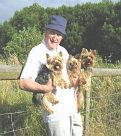|
When traveling around the Cotswolds and The Vale of Evesham on a summer evening, with the sun low in the sky, its impossible not to notice rows of humps in the fields. There are line upon line of them, some straight and many that curve slightly. What you are seeing are the remnants of an ancient ploughing method that we call ridge and furrow.
In Anglo-Saxon times, families owned strips of land with their neighbours farming adjacent strips. They used oxen to pull their ploughs, horses being used mainly for military purposes. The plough blade cut the turf and forced the soil against a board, which turned it over and moved it sideways. At the end of the field, the oxen would loop round to come back down the field to pile the soil against the first cut. By going round your land in this manner, the effect was to push the soil in towards the middle and create a long heap. Besides increasing the surface area of your strip, it assisted drainage. Over many seasons, the ridge would get higher and the furrow would go deeper so it's no surprise to see them as a prominent feature in our landscape today. Its hard work walking across a series of ridge and furrows as I have found from experience and I can vouch for the effectiveness of the drainage when every furrow can be quite boggy, even in dry weather. In some places, the furrow can even support the growth of rushes and different types of grass which makes the ridge and furrow pattern easy to see even if there are no evening shadows.
On the heavier soils of the Vale farmers could use up to eight oxen positioned two abreast and secured together with yokes before being attached to the plough. They didn't use bridles or reins to control the oxen so the ploughman worked with a boy who carried a long stick which he used to keep the oxen moving by reaching across and giving them a tap. At the end of the field the plough boy used his stick to drive the oxen round in a half circle, then guide them back down the field, and so continue the ploughing.
The plough boy's stick had a name, it was called a rod, pole or perch depending on locality and at 5.5 yards long was just the right length to reach the far oxen, and not too heavy to carry. If the rod was laid 4 times across the field, that made 22 yards, if it was laid 40 times down the field, that made 220 yards, and the area was called 1 acre, the amount a ploughman and his boy could plough in a day in the available daylight hours.
The breadth of 22 yards was known as a chain, the length of a cricket pitch and the length of 220 yards was known as a farrowlength or as we call it today, a furlong.
During the late 800s and early 900s AD with a threat of Danish invasion into the West of England, the Saxon Kings re-ordered the countryside by creating communities of villages and building defences around the towns. The ridge and furrow strips were brought together into estates and boundaries became more defined with the planting of hedgerows. Many of these ancient hedgerows survive to this day giving us a living link to our Anglo-Saxon ancestors. The threat of Danish attack generated a more collective type of farmer.
In the following centuries the population expanded and farming changed to meet new demands. The ridge and furrow returned to grassland to support cattle and sheep leaving us with those humps in the ground so clearly seen on a summer evening.
It's interesting to think that the dimensions used by our Anglo-Saxon ancestors are still known to us over 1000 years later; and the size of an ox and a boy carrying a rod, pole or perch helped to define the nature of our English countryside.
For further information on this ancient agricultural system see the English Heritage website. |



